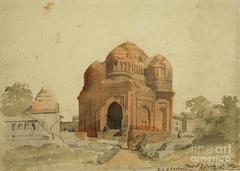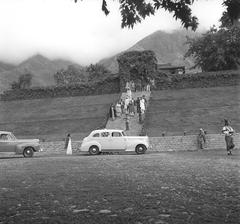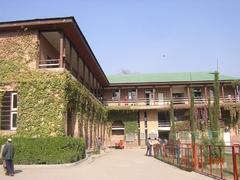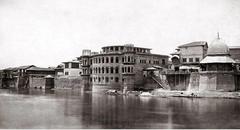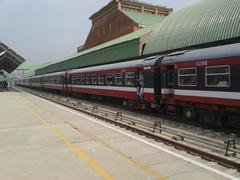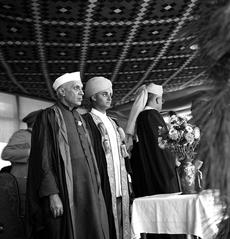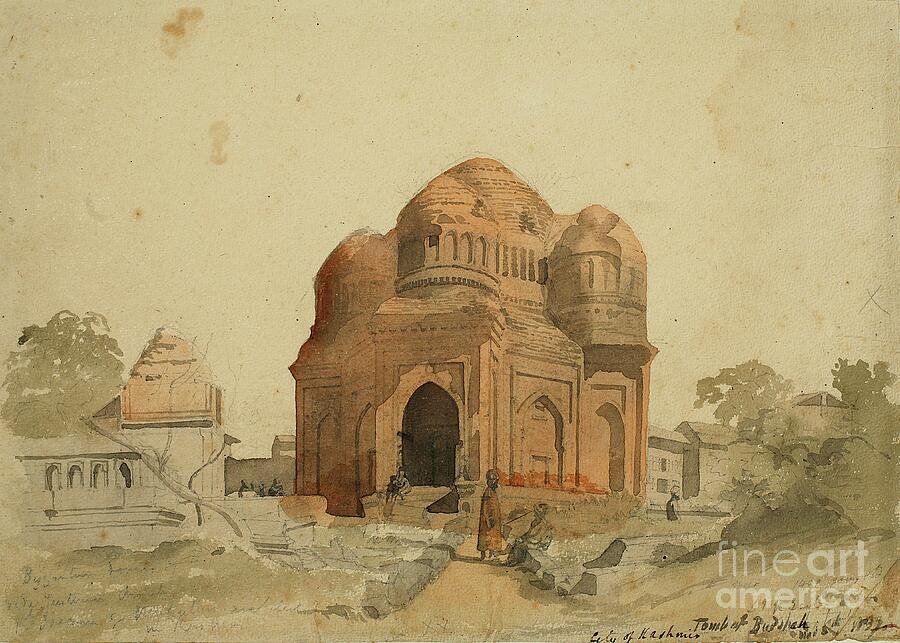
Tomb of Zain-ul-Abidin’s Mother, Srinagar: Visiting Hours, Tickets, and Historical Significance
Date: 14/06/2025
Introduction
The Tomb of Zain-ul-Abidin’s Mother, also known as Budshah’s Tomb or the Madin Sahib Tomb, stands as one of Srinagar’s most iconic monuments—a testament to Kashmir’s rich historical and cultural legacy. Built in the 15th century to honor Queen Miran, the revered mother of Sultan Zain-ul-Abidin (Budshah, “the Great King”), this mausoleum embodies an era of religious tolerance, artistic innovation, and social reform (Kashmir Times; Sahapedia). Its unique Indo-Islamic architectural style—fusing Central Asian, Persian, and indigenous Kashmiri elements—makes it a must-visit for travelers, historians, and architecture enthusiasts alike (Archnet; The Kashmir Archive).
Historical Context and Origins
Sultan Zain-ul-Abidin’s reign (1420–1470 CE) is widely regarded as Kashmir’s golden age, marked by profound religious harmony, artistic patronage, and progressive social policies (Kashmir Times). The construction of this tomb for his mother, Queen Miran (sometimes referred to as Meradevi), was both a personal tribute and a rare recognition of maternal influence in medieval South Asian history. The site itself occupies ground with deep historical roots, once home to a Buddhist monastery, reflecting Kashmir’s diverse religious and cultural layers (The Islamic Heritage).
Architectural Features and Significance
Layout and Structure
The tomb is celebrated as the earliest surviving brick masonry structure in Kashmir, marking a significant evolution from the region’s traditional wooden architecture (The Kashmir Archive). Inspired by Timur’s Gur-i-Amir in Samarkand, it features:
- Octagonal brick plan: A central domed chamber with four auxiliary domes arranged in a symmetrical cross-shaped layout,
- Pyramidal wooden roof: Diminishing tiers capped with a lotus-shaped finial for both structural integrity and symbolism,
- Glazed blue tiles and molded brickwork: Adorning the exterior with geometric and floral motifs,
- Jali screens: Intricately carved lattice windows allowing filtered light and ventilation,
- Decorative elements: Stone carvings, Persian and Arabic calligraphy, and chhatris at each corner reflecting Kashmiri syncretism (Archnet; Sahapedia).
Synthesis of Influences
The tomb’s architecture is a masterful blend of Central Asian, Persian, and indigenous Kashmiri elements—pointed arches, calligraphic bands, and timber construction—adapted to local climates and cultural contexts. Unlike later Mughal mausoleums, its scale is modest, but its artistry is profound. The site’s walled enclosure, once home to lush gardens, further reflects Persianate influences (INTACH Kashmir).
Cultural and Social Significance
Constructing a royal tomb for a queen mother was an exceptional act in medieval South Asia, highlighting Sultan Zain-ul-Abidin’s respect for women and progressive vision (The Kashmir Archive). The mausoleum stands as a symbol of Kashmir’s syncretic traditions—bridging Buddhist, Hindu, and Islamic influences—and is part of the larger royal necropolis, Mazar-i-Salateen. It embodies values of religious tolerance, social reform, and gender recognition, and remains an active site of pilgrimage and cultural identity, hosting annual gatherings and prayers (Tour Travel World).
Visitor Information
Location and Accessibility
- Address: Nohata, Mahraji Gunj area, downtown Srinagar (3RW4+2C5, Nohata, Srinagar, Jammu and Kashmir 190002)
- Proximity: About 5.5 km from Srinagar Railway Station and near the historic Zaina Kadal bridge
- Access: Reachable by local taxi, auto-rickshaw, or private vehicle; expect narrow lanes and bustling markets (yappe.in)
Opening Hours and Tickets
- Hours: Open daily from 8:00/9:00 AM to 5:00/6:00 PM (hours vary slightly by source)
- Entry Fee: Entry is generally free, though some sources mention a nominal fee (INR 20 for Indians, INR 100 for foreigners); unofficial photography charges may apply—clarify with staff on arrival
Facilities and Amenities
- No dedicated tourist facilities at the tomb; restrooms, eateries, and accommodations are available nearby in Mahraji Gunj and downtown Srinagar (e.g., Down Town Cafe, Muneer Cafeteria, HOTEL ROOMA)
Accessibility
- For differently-abled visitors: Moderate accessibility with paved but uneven paths; assistance is advised
- Safety: Site is safe during daylight, but exercise standard precautions in crowded lanes
Dress Code and Conduct
- Modest attire (covering shoulders and knees) is recommended; women should carry a headscarf
- Remove shoes before entering certain areas; maintain a respectful demeanor and keep noise to a minimum
Visitor Experience
Site Layout
- The tomb complex features the main mausoleum, Sultan Zain-ul-Abidin’s grave outside, and other family graves
- The serene gardens and sacred landscape enhance its spiritual ambiance
Photography
- Photography is generally allowed but seek explicit permission before shooting, especially during prayers or community events; some staff may ask for a small fee
Best Time to Visit
- Spring (March–May) and autumn (September–November) offer pleasant weather and optimal conditions for sightseeing and photography
Nearby Attractions
- Pathar Masjid: Renowned for its stone architecture
- Khanqah-e-Moula: Revered Sufi shrine with intricate woodwork
- Shah-e-Hamdan Mosque: An important religious and architectural landmark
- Hazratbal Shrine and Shankaracharya Temple: Complement your cultural itinerary
Conservation and Modern Relevance
Restoration efforts by the Archaeological Survey of India and heritage organizations like INTACH have preserved the tomb’s core features despite urban encroachment and environmental challenges (INTACH Kashmir). The site remains a focal point for community life, cultural education, and heritage tourism.
Travel Tips
- Allocate extra travel time for navigating downtown Srinagar’s congested lanes
- Carry small cash for local purchases and potential photography fees
- Bring bottled water; restroom facilities are limited
- Stay updated on local advisories for security or weather
- English is widely understood; Urdu and Kashmiri are common
Frequently Asked Questions (FAQs)
Q: What are the visiting hours?
A: Generally 8:00 or 9:00 AM to 5:00 or 6:00 PM daily.
Q: Is there an entry fee?
A: Usually free, but some sources mention nominal fees; clarify on arrival.
Q: Are guided tours available?
A: Yes, through local heritage organizations and tour operators.
Q: Is photography allowed?
A: Typically yes, but seek permission and be aware of possible fees.
Q: Is the site accessible for people with disabilities?
A: Moderate accessibility; assistance is recommended for mobility challenges.
Q: What other attractions are nearby?
A: Pathar Masjid, Khanqah-e-Moula, Hazratbal Shrine, Shankaracharya Temple, and more.
Visuals and Media
High-quality images and virtual tours are available via Sahapedia and Archnet.
Image 1 Alt Tag: Front view of the Tomb of Zain-ul-Abidin’s Mother showcasing blue-glazed brickwork.
Image 2 Alt Tag: Interior dome and jalli work of Budshah’s Dumath in Srinagar.
Image 3 Alt Tag: Serene garden surrounding the Tomb of Zain-ul-Abidin’s Mother, a famous Srinagar historical site.
Summary and Recommendations
The Tomb of Zain-ul-Abidin’s Mother encapsulates the spirit of Kashmir’s golden age—a harmonious blend of architectural genius, cultural synthesis, and profound historical significance (The Kashmir Archive; Kashmir Times). Its unique features, from blue-glazed tiles and octagonal plan to intricate jali screens, offer a window into a vibrant period of artistic and social innovation (Archnet). As a living monument, it continues to inspire, educate, and foster a sense of shared heritage among locals and visitors alike.
Plan your visit to discover this serene and inspiring site. For up-to-date travel tips, guided tours, and cultural events, download the Audiala app and follow heritage platforms on social media.
Sources and Further Reading
- Kashmir Times: A Monument to Kashmir’s Greatest Ruler and His Mother
- Sahapedia: Tomb of Madin Sahib, Srinagar
- Archnet: Tomb of Madin Sahib, Srinagar
- The Kashmir Archive: Tomb of Sultan Zain-ul-Abideens Mother
- Tour Travel World: Tomb of Zain-ul-Abidin, Srinagar
- INTACH Kashmir: Tomb of Madin Sahib
- Yappe: Tomb of Zain-ul-Abidin’s Mother, Srinagar
